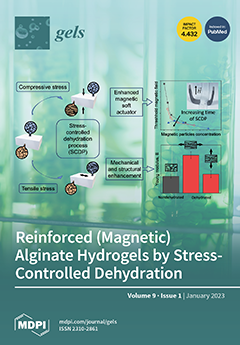We report the synthesis of mesoporous silica–gelatin hybrid aerogels with 15, 25, and 30 wt. % gelatin contents, using 3-glycidoxypropyl trimethoxysilane (GPTMS) as a coupling agent, for tissue-engineering applications. Aerogels were obtained using a one-step sol–gel process followed by CO
2 supercritical drying,
[...] Read more.
We report the synthesis of mesoporous silica–gelatin hybrid aerogels with 15, 25, and 30 wt. % gelatin contents, using 3-glycidoxypropyl trimethoxysilane (GPTMS) as a coupling agent, for tissue-engineering applications. Aerogels were obtained using a one-step sol–gel process followed by CO
2 supercritical drying, resulting in crack-free monolith samples with bulk densities ranging from 0.41 g cm
−3 to 0.66 g cm
−3. Nitrogen adsorption measurements revealed an interconnected mesopore network and a general decrease in the textural parameters: specific surface areas (651–361 m
2 g
−1), pore volume (1.98–0.89 cm
3 g
−1), and pore sizes (10.8–8.6 nm), by increasing gelatin content. Thermogravimetric analysis (TGA), Fourier-transform infrared (FTIR) spectroscopy and uniaxial compression experiments confirmed that the structure, thermal properties and mechanical behavior of these aerogels changed significantly when the concentration of gelatin reached 25 wt.%, suggesting that this composition corresponds to the percolation threshold of the organic phase. In addition, the samples exhibited hydrophilic behavior and extremely fast swelling in phosphate-buffered saline (PBS), with swelling ratios from 2.32 to 3.32. Furthermore, in vitro bioactivity studies revealed a strong relationship between the kinetics of the nucleation and growth processes of hydroxyapatite in simulated body fluid (SBF) and the gelatin content. The live/dead assay revealed no cytotoxicity in HOB
® osteoblasts in vitro and a positive influence on cell growth, focal adhesion development, and cytoskeletal arrangement for cell adhesion. Mineralization assays confirmed the positive effects of the samples on osteoblast differentiation. The biomaterials described are versatile, can be easily sterilized and are suitable for a wide range of applications in bone tissue-engineering, either alone or in combination with bioactive-reinforced phases.
Full article






